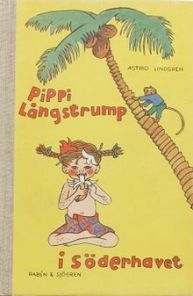Pippi in the South Seas
The Pippi Longstocking books are written by Swedish Author Lingren in the 1940s, covering the adventures of Pippi, an inveterate liar and eccentric whose parents are dead and shares her house with a monkey and a horse that lives on the porch. And Pippi in the South Seas is the third sequels, released in 1948 after Pippi Longstocking and Pippi Goes on on Board.
Plot
In this book, a few of Pippi's newer experiences include her warding off a snobbish, portly tourist who believes Villa Villekulla, her home, to be for sale and dismisses her as ugly and ridiculous; inadvertently mouthing off to a teacher from Tommy and Annika Settergren's school during an examination of pupils; and entertaining Tommy and Annika while they are sick with measles. She also soon receives word from her father, a sea captain who had seemingly vanished earlier, inviting her to a tropical island inhabited by natives, which he now reigns as king. Pippi and her friends sail to her father's island kingdom, where they become acquainted with the natives living there, Pippi being hailed as "Princess Pippilotta."
Controversy
Books about Pippi Longstocking have been described as racist by German theologian, Dr. Eske Wollrad. She claimed that Lindgren’s classic children novels have colonial racist stereotypes. In Pippi in the South Seas, there is a passage, “the black children throw themselves into the sand in front of the white children.” She clarified that it is not the figure of Pippi Longstockings is racist, but all three in the trilogy books have colonial racist stereotypes.
Astrid Lingren’s daughter Karin Nyman rejected the accusation by saying that LIngren is the opposite of racist. She is not only against adultism, grown-ups being in charge, and fiercely opposed to violence against animals, but she certainly is also against racism. The passage quoted by Eske Wollrad, where the 'black children throw themselves into the sand' in front of Pippi and Tommy and Annika, is explicitly preceded by the explanation that they did so thinking, 'for some incomprehensible reason', that white skin was to be revered. This passage is referring to colonial racist stereotypes, but since that sentence is immediately questioned by Pippi, who refuses to be knelt in front of, who makes a very strong point of the children being all alike, black and white, and enjoying the same games in the two books dealing with the South Seas, it is difficult to see the books as representatives of a dubious racist conception and thus harming reading children of to-day. But, the old harm of colonial racism itself remains.[1]
In 2009, Hamburg publishing house named Friedrich Oetinger printed a new version of "Pippi Longstocking" where Pippi's father name was changed from the "Negro King" to the "South Sea King." The publisher had kept the original text in previous edition, but they included a footnote explaining that the terminology is no longer in use.[2]
References
- ↑ Flood, Alison (2015). Pippi Longstocking books charged with racism . Retrieved on December 18, 2020.
- ↑ Wilder, Charly (2013). Redacting Racism Edit of Classic Children's Book Hexes Publisher . Retrieved on December 18, 2020.
